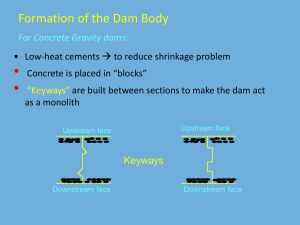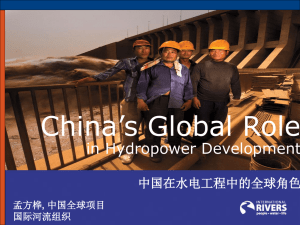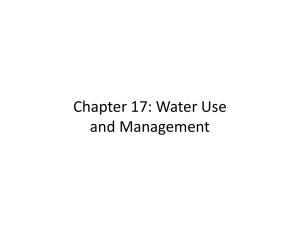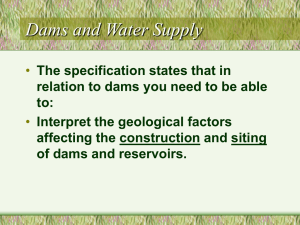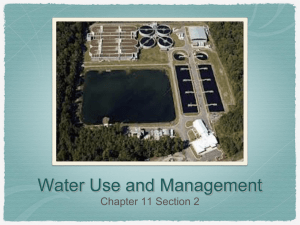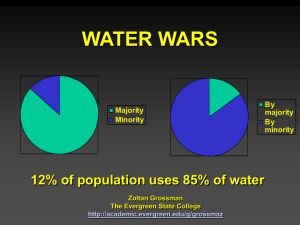Barajlar ve Baraj Hazneleri
advertisement
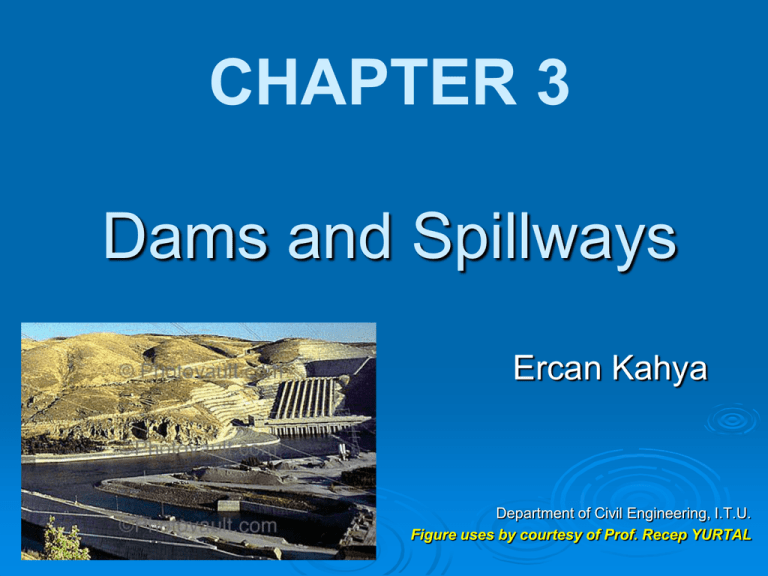
CHAPTER 3 Dams and Spillways Ercan Kahya Department of Civil Engineering, I.T.U. Figure uses by courtesy of Prof. Recep YURTAL I.T.U., Department of Civil Eng. I.T.U., Department of Civil Eng. Embankment (Fill) Dams I.T.U., Department of Civil Eng. Environmental Effects of Dams Social and economic effects Ecologic effects Regional climate effects Vegetation effects Fishery Navigation effects Upstream and downstream navigation effects Tourism effects 3.1 Classification of Dams According to dams height If crest elevation and foundation level greater than 15 m Large Dam If dam height less than 15 m Small Dam If dam height greater than 50 m High Dam More specifically The height of the dam > 15 m The crest width of the dam > 500 m The storage volume of the dam > 106 m3 “LARGE DAM” Classification of Dams According to construction purpose Single purpose ■ Storage Dams ■ Diversion Dams ■ Detention Dams ■ Hydropower Dams Multiple purpose (Serves for all or most of the above purposes) Drinking water Irrigation Flood control Energy Navigation Recreational purposes I.T.U., Department of Civil Eng. Classification of Dams According to Hydraulic Design ■ Overflow Dams (i.e., diversion dams) ■ Non-overflow Dams (i.e., earth fill & rock fill dams) Classification of Dams According to Materials of Construction ■ Embankment Dams • Earth-Fill Dams • Rock-Fill Dams ■ Masonry and Rubble Dams ■ Concrete Dams ■ Steel and Timber Dams Classification of Dams According to Structural Design Gravity Dams Arch Dams Buttress Dams Earth-Fill Rock-Fill Pre-stressed Concrete Dams According to Structural Design Recep YURTAL Ç.Ü., İnş.Müh.Böl. Recep YURTAL Ç.Ü., İnş.Müh.Böl. www.altunkaynak.net Recep YURTAL Ç.Ü., İnş.Müh.Böl. Embankment (Fill) Dams 3.2 Parts of Dams Structural components: - Body - Spillway - Outlet Facilities (i.e., sluiceways & water intake tower) - Others (i.e., hydropower stations, roads, fish ladder, etc.) 3.3 Planning of Dams Three steps: - Reconnaissance surveys (Infeasible alternatives eliminated) - Feasibility study - Planning study Planning of Dams 3.3.1 FEASIBILITY STUDY A) Determination of water demand B) Determination of water potential C) Optimal plans ◘ Check out the relation D (demand) versus S (supply). Planning of Dams FEASIBILITY STUDY D) Determination of dam site ◘ Factors should be taken into consideration: Topography Geology and dam foundation Available of construction materials Flood hazard Seismic hazard Spillway location and possibilities Construction time Climate Diversion facilities Sediment problem Water quality Transportation facilities Right of way cost Planning of Dams E) Determination of type of dam ◘ Comparative characteristics of dams should be considered F) Project design ◘ involves the computation of dimensions of the dam. - Hydrologic design (max. lake elevation + spillway cap. + crest elevation) - Hydraulic design (static & dynamic loads + spillway profile + outlet dimensions) - Structural design (stress distribution + required reinforcement) ◘ Failure of the dam “ ” It is rapid for a concrete dam. See the textbook for the examples. Planning of Dams 3.3.2 PLANNING STUDY ◘ Followings need to be done in planning certain type of dam, since dimensions are already determined: a)Topographic surveys (1:5000 scaled map) b)Foundation study (seepage permeability etc. tests) c)Materials study (quantity of materials) d)Hydrologic study (measurements of hydrologic parameters) e)Reservoir operation study (is to be performed periodically) 3.4 Construction of Dams Four principal steps are followed during the construction: 1) Evaluation of Time Schedule and Equipment ◘ a work schedule is prepared using CPM. (characteristics of dam site; approx. quantities of works; diversion facilities; urgency of work) 2) Diversion ◘ before the construction, river flow must be diverted from the site ◘ see the below figure for two possible ways to divert water: Cofferdam Cofferdam Construction zone Cofferdam (b) Flow in stream bed (a) Construction zone First stage Diversion tunnel Downstream Flow through sluiceway Diversion by tunnel Second stage Completed portion of dam River Diversion facilities Construction zone Diversion tunnel Upstream (c) 3) Foundation Treatment ◘ Concrete & Rock-fill dams hard formations Earth-fill dams most of soil conditions ◘ Highly porous foundation excessive seepage, uplift, settlement “Grouting Operation” is applied to solidify the foundation & to reduce seepage Formation of the Dam Body For Concrete Gravity dams: • Low-heat cements to reduce shrinkage problem • • Concrete is placed in “blocks” “Keyways” are built between sections to make the dam act as a monolith Upstream face Upstream face Keyways Downstream face Downstream face • “Waterstops” are placed near upstream face to prevent leakage Copper strip Copper strip Waterstops “Inspection galleries” permit access to the interior of concrete Dams and are needed for seepage determination, grouting operations and etc. For Earth-fill dams • • • • • Constructed in multi-layer formation (Layers: impervious, filter and outer) First place the materials in layers of 50 cm and then compact these materials. For high dams, horizontal berms are constructed to enhance slope stability Protect the upstream face of dam against wave action (i.e., concrete or riprap) Protect the downstream face against rainfall erosion (i.e., planting grass or riprap) Cross section of typical earth dams Silt Silt clay Sandy gravel (a) Simple zoned embankment Silt Pervious strata Clay core Silt Rock-fill toe Transition zone Pervious foundation (b) Earth dam with core extending to impervious foundation Cross section of typical earth dams Clay blanket Silt clay Silt Sandy gravel Pervious material Concrete cutoff wall (c) Earth dam on pervious material For Rock-fill dams: • Core and filter zones are similarly constructed as the earth dam • Due to heavy rocks on the sides, these dams • have steeper slopes • have less materials • are economic • Construction period is shorter and easy to increase the crest elevation Width of dam crest: There are two traffic lanes Elevation of dam crest: There is no overtopping during design flood Freeboard: See the table for recommendations Select Compacted Rock Rolled Medium Size Rock 1.3 1 1.3 1 Coarse Dumped Rock Reinforced Concrete Membrane Cutoff wall (a) Impermeable face Cross-section of typical Rock-fill dams 1.4 Graded transition sections 1.4 1 1 Dumped or Rolled rock (b) Impermeable earth-core Rolled rock (0.2m) Grout curtain (1.5m) GRAVITY DAMS Recep YURTAL Recep YURTAL Ç.Ü. İnş.Müöl. Concrete Gravity Dams Resist the forces by their own weight Recep YURTAL Ç.Ü. İnş.Müöl. Concrete Gravity Dams Recep YURTAL Ç.Ü. İnş.Müöl. Concrete Gravity Dams Recep YURTAL Ç.Ü. İnş.Müöl. Concrete Gravity Dams Recep YURTAL Ç.Ü. İnş.Müöl. Concrete Gravity Dams Why & Where we prefered? Sağlam ve geçirimsizliği sağlanabilecek yeterli kalınlıkta kaya temellerin uygun bir derinlikte bulunduğu orta genişlikteki vadilerde Yeterli miktarda ve istenen özellikte agrega malzemesinin bulunduğu, çimento naklinin ekonomik olduğu yerlerde Büyük taşkın debilerinin baraj gövdesi üzerinden mansaba aktarılması gereken durumlarda Baraj üzerinden bir ulaşım yolu geçirilmesi gereken durumlarda tercih edilir Savaş ve sabotaja karşı daha dayanıklı olması da ayrıca bir tercih nedeni olabilir. Recep YURTAL Ç.Ü. İnş.Müöl. Concrete Gravity Dams Types: • Straight Gravity Dams • Arch Gravity Dams Baraj ekseni, iki yamaç arasındaki en kısa bağlantıyı sağlayacak şekilde bir doğru ile birleştirilir. Temel kayasının yapısına, derzlere veya emniyet ihtiyacına bağlı olarak kavisli de yapılabilir. Recep YURTAL Ç.Ü. İnş.Müöl. Concrete Gravity Dams Design Criteria: En uygun kesit, etki eden en önemli dış kuvvet olan haznedeki hidrostatik su basıncı dağılımına uyum sağlayan, tabana doğru genişleyen üçgen kesit seçilir. Üçgenin tepesi genellikle haznedeki en yüksek su seviyesidir. Memba yüzeyi düşey veya %10 ‘u geçmeyecek şekilde eğimli yapılır. Baraj boş haldeyken çekme gerilmelerini önlemek, dolu haldeyken kayma ve devrilme emniyetini artırmak için yüksek barajlarda memba yüzeyi genellikle eğimli planlanır. Üçgenin tepe kısmında, duvar kalınlığını artırmak, yamaçlar arası ulaşımı sağlamak gibi nedenlerle dikdörtgen kesitli bir başlık bulunur. Recep YURTAL Ç.Ü. İnş.Müöl. Concrete Gravity Dams Design Criteria: Recep YURTAL Ç.Ü. İnş.Müöl. Concrete Gravity Dams Design Principles: Ağırlık barajı hesaplarında üçgen profil gözönüne alınır. H Üçgen kesitin minimum boyutları, barajın kendi ağırlığı, hidrostatik su basıncı ve taban su basıncının etki ettiği normal yükleme durumunda çekme gerilmeleri meydana gelmeyecek şekilde belirlenir. Bunun için: tg b H b b Recep YURTAL Ç.Ü. İnş.Müöl. 1 m Concrete Gravity Dams For the dam dimensions: Check out the safety for • Overturning • Shear & sliding • Bearing capacity of foundation • No tensile stresses are allowed in the dam body Overturning Check 1/md H B Recep YURTAL Ç.Ü. İnş.Müöl. Overturning Check H B Recep YURTAL Ç.Ü. İnş.Müöl. Overturning Check H B Recep YURTAL Ç.Ü. İnş.Müöl. Overturning Check H B Recep YURTAL Ç.Ü. İnş.Müöl. Overturning Check H B Recep YURTAL Ç.Ü. İnş.Müöl. Overturning Check H B Recep YURTAL Ç.Ü. İnş.Müöl. Sliding Check 1/md H B Recep YURTAL Ç.Ü. İnş.Müöl. Sliding Check H B Recep YURTAL Ç.Ü. İnş.Müöl. Sliding Check H B Recep YURTAL Ç.Ü. İnş.Müöl. Sliding Check H B Recep YURTAL Ç.Ü. İnş.Müöl. Sliding Check 1/md H B Recep YURTAL Ç.Ü. İnş.Müöl. Bearing Capacity Check 1/md H Recep YURTAL Ç.Ü. İnş.Müöl. 3.5.1 FORCES ON GRAVITY DAMS Free body diagram showing forces acting on a gravity dam The following loads should be considered: A) WEIGHT (WC): Dead load and acts at the centroid of the section B) HYDROSTATIC FORCES: Water in the reservoir + tailwater causes Horizontal Hu Hd & Vertical Fh1v Fh2v C) UPLIFT FORCE (Fu): acts under the base as: D) FORCE OF SEDIMENT ACCUMULATION (Fs): Determined by the lateral earth pressure expression where • Fs : the lateral earth force per unit width, • γs : the submerged specific weight of soil, • hs : the depth of sediment accumulation relative to reservoir bottom elevation, • θ : the angle of repose. This force acts at hs /3 above the reservoir bottom. E) ICE LOADS (Fi): considered in cold climate Ice force per unit width of dam (kN/m) can be determined from the following table: Thickness of ice sheet (cm) Change in temperature (oC/hr) 2.5 5 7.5 25 30 60 95 50 58 90 150 75 75 115 160 100 100 140 180 F) EARTHQUAKE FORCE (Fd): Acting horizontally and vertically at the center of gravity k (earthquake coefficient): Ratio of earthquake acceleration to gravitational acceleration. G) DYNAMIC FORCE (Fw) : In the reservoir, induced by earthquake as below Acts at a distance 0.412 h1 from the bottom • Fw : the force per unit width of dam • C : constant given by ' • θ’ : angle of upstream face of the dam from vertical (oC) • For vertical upstream face C = 0.7 H) FORCES ON SPILLWAYS (∑F): Determined by using momentum equation btw two successive sections: • ρ : the density of water • Q : the outflow rate over the spillway crest • ΔV: the change in velocity between sections 1 and 2 (v2-v1) Momentum correction coefficients can be assumed as unity. I) WAVE FORCES : Considered when a long fetch exists LOADING CONDITIONS: Usual loading B &Temperature Stresses at normal conditions + C + A + E + D Unusual loading B & Temperature Stresses at min. at full upstream level + C + A +D Severe loading Forces in usual loading + earthquake forces 3.5.2 STABILITY CRITERIA Dam must be safe against (1) Overturning for all loading conditions FS O Mr Mo Safety factor: F.SO 2,0 (usual loading) F.SO 1,5 (unusual loading) resisting moments overturning moments STABILITY CRITERIA (2) Sliding over any horizontal plane FSs = f åV åH f = friction coef. btw any two planes Safety factor: FSS 1,5 (usual loading ) FSS 1,0 (unusual or severe loading) STABILITY CRITERIA (3) Shear and sliding together FSss = f åV + 0.5A t s åH A : Area of shear plane (m²) τs : Allowable shear stress in concrete in contact with foundation Safety factor: FSss 5,0 (usual loading) FSss 3,0 (unusual or severe loading) STABILITY CRITERIA (4) Between foundation and dam contact stresses (σ) > 0 at all points There are two cases for the base pressure: Mr - Mo x= åV B e= -x 2 Base Pressure Check CASE 1: e B/6 æ åV ö æ 6e ö ÷ ´ ç1+ ÷ Pt s Pt = ç ç B ÷ è Bø è ø æ åV ö æ 6e ö ÷ ´ ç1- ÷ Ph s Ph = ç ç B ÷ è Bø è ø B DAM BASE Ph Pt e x ΣV Recep YURTAL Ç.Ü. İnş.Müöl. Base Pressure Check B CASE 2: e > B/6 DAM BASE æ ö ÷ æ åV ö ç 1 ÷´ç ÷ Pt = ç ç B ÷ ç æ 3 ö æ 1 e ö ÷ Pt s è ø çç ÷´ç - ÷÷ èè 2 ø è 2 B øø Recep YURTAL Ç.Ü. İnş.Müöl. Pt x e ΣV


